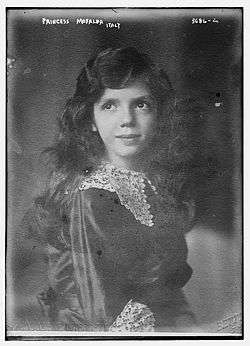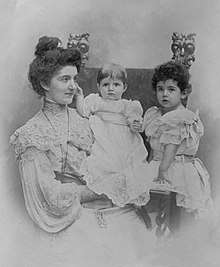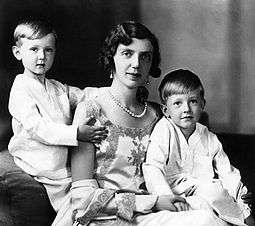Princess Mafalda of Savoy
Princess Mafalda of Savoy (2 November 1902 – 27 August 1944) was the second daughter of King Victor Emmanuel III of Italy and his wife Elena of Montenegro. The future King Umberto II of Italy was her younger brother.
| Mafalda | |||||
|---|---|---|---|---|---|
| Landgravine of Hesse | |||||
 Princess Mafalda between 1910 and 1915 | |||||
| Born | 2 November 1902 Rome, Kingdom of Italy | ||||
| Died | 27 August 1944 (aged 41) Buchenwald Concentration Camp, Nazi Germany | ||||
| Burial | |||||
| Spouse | Philipp, Landgrave of Hesse | ||||
| Issue | Prince Moritz Prince Heinrich Prince Otto Princess Elisabeth | ||||
| |||||
| House | Savoy | ||||
| Father | Victor Emmanuel III of Italy | ||||
| Mother | Elena of Montenegro | ||||
| Religion | Roman Catholic | ||||
Biography

Mafalda was born in Rome. In childhood she was close to her mother, from whom she inherited a love for music and the arts. During World War I, she accompanied her mother on her visits to Italian military hospitals.
On 23 September 1925, at Racconigi Castle, Mafalda married Prince Philipp of Hesse, Landgrave of Hesse-Kassel and grandson of German Emperor Frederick III.[1] Prince Philipp and his brother Christoph were members of the National Socialist (Nazi) party.
Prince Philipp's marriage to Princess Mafalda put him in position to act as intermediary between the National Socialist government in Germany and the Fascist government in Italy. On the evening of the 26 March 1935 she was present at an informal diplomatic dinner given by Adolf Hitler in the Reich President's House in Berlin. She sat next to Anthony Eden.[2]
However, during World War II, Adolf Hitler believed Princess Mafalda was working against the war effort; he called her the "blackest carrion in the Italian royal house". So did Hitler's Minister of Propaganda Joseph Goebbels, who called her "the biggest bitch (grösste Rabenaas) in the entire Italian royal house".[3]
Early in September 1943, Princess Mafalda travelled to Bulgaria to attend the funeral of her brother-in-law, King Boris III. While there, she was informed of Italy's surrender to the Allied Powers, that her husband was being held under house arrest in Bavaria, and that her children had been given sanctuary in the Vatican. The Gestapo ordered her arrest, and on 23 September she received a telephone call from Hauptsturmführer Karl Hass at the German High Command, who told her that he had an important message from her husband. On her arrival at the German embassy, Mafalda was arrested, ostensibly for subversive activities. Princess Mafalda was transported to Munich for questioning, then to Berlin, and finally to Buchenwald concentration camp.
On 24 August 1944, the Allies bombed an ammunition factory inside Buchenwald. Some four hundred prisoners were killed and Princess Mafalda was seriously wounded: she had been housed in a unit adjacent to the bombed factory, and when the attack occurred she was buried up to her neck in debris and suffered severe burns to her arm. The conditions of the labour camp caused her arm to become infected as a result, and the medical staff at the facility amputated it; she bled profusely during the operation and never regained consciousness. She died during the night of 26–27 August 1944; her body was reburied after the war at Kronberg Castle in Hesse.[4]
Eugen Kogon, author of The Theory and Practice of Hell – The German Concentration Camps and the System Behind Them (1950), adds more details of Mafalda's death – some of it in conflict with the previous account. After the air raid of 24 August 1944, the princess was wounded in the arm and Dr. Schiedlausky, camp medical office, performed the arm amputation, but his patient did not survive due to loss of blood. Her naked body was dumped into the crematorium, where Father Joseph Thyl, dug it out of the body heap, covered her up, and arranged for speedy cremation. Thyl cut off a lock of the princess's hair, which was smuggled out of camp to be kept in Jena, until it could be sent on to her German relatives. Her death was not confirmed until after Germany's surrender to the Allies in 1945.[5]
In 1997, the Italian government honored Princess Mafalda with her image on a postal stamp. Mafaldine (little Mafaldas), a variety of flat pasta, are named after her.
Children

Princess Mafalda married Philipp, Landgrave of Hesse on 23 September 1925 (civil & religious) at Racconigi Castle near Turin. They had the following children:
- Prince Moritz, Landgrave of Hesse (6 Aug 1926 – 23 May 2013) married Princess Tatiana of Sayn-Wittgenstein-Berleburg (31 July 1940 Gießen) {divorced 16 October 1974} Had issue.
- Prince Heinrich Wilhelm Konstantin Viktor Franz (30 Oct 1927 Villa Savoia, Rome – 18 November 1999 Schloß Wolfsgarten, Langen); Unmarried-no issue.
- Prince Otto Adolf (3 June 1937 Rome – 3 January 1998 Hanover)
- Married 1st on 5 April 1965 (civil) in Munich and 6 April 1965 (religious) in Trotsberg Angela Mathilde Agathe von Doering (12 Aug 1940 Goslar – 11 April 1991 Hanover). {div. 3 February 1969} No issue.
- Married 2nd on 28 December 1988 to Elisabeth Marga Dorothea Bönker[6] (formerly Wittler)[7] (31 Jan 1944 Rumburg, Czechoslovakia – 12 April 2013). {div. 1994} No issue.
Title, styles and honours
Titles and styles
- 2 November 1902 – 23 September 1925: Her Royal Highness Princess Mafalda of Savoy
- 23 September 1925 – 27 May 1940: Her Royal Highness Princess Mafalda of Hesse, Princess of Savoy
- 27 May 1940 – 27 August 1944: Her Royal Highness The Landgravine of Hesse
Honours
_crowned.svg.png)
.svg.png)
Ancestry
| Ancestors of Princess Mafalda of Savoy | |||||||||||||||||||||||||||||||||||||||||||||||||||||||||||||||||||||||||||||||||||||||||||||||||||||||||||||||||||||||||||||||||||||||||||||||||||||||||||||||||||||||||||||||||||||||||||||||||||||||||||||||||||||||||||||||||||||||||||||||||||||||||||||||||||||||||||||||||||||||||
|---|---|---|---|---|---|---|---|---|---|---|---|---|---|---|---|---|---|---|---|---|---|---|---|---|---|---|---|---|---|---|---|---|---|---|---|---|---|---|---|---|---|---|---|---|---|---|---|---|---|---|---|---|---|---|---|---|---|---|---|---|---|---|---|---|---|---|---|---|---|---|---|---|---|---|---|---|---|---|---|---|---|---|---|---|---|---|---|---|---|---|---|---|---|---|---|---|---|---|---|---|---|---|---|---|---|---|---|---|---|---|---|---|---|---|---|---|---|---|---|---|---|---|---|---|---|---|---|---|---|---|---|---|---|---|---|---|---|---|---|---|---|---|---|---|---|---|---|---|---|---|---|---|---|---|---|---|---|---|---|---|---|---|---|---|---|---|---|---|---|---|---|---|---|---|---|---|---|---|---|---|---|---|---|---|---|---|---|---|---|---|---|---|---|---|---|---|---|---|---|---|---|---|---|---|---|---|---|---|---|---|---|---|---|---|---|---|---|---|---|---|---|---|---|---|---|---|---|---|---|---|---|---|---|---|---|---|---|---|---|---|---|---|---|---|---|---|---|---|---|---|---|---|---|---|---|---|---|---|---|---|---|---|---|---|---|---|---|---|---|---|---|---|---|---|---|---|---|---|---|---|---|
| |||||||||||||||||||||||||||||||||||||||||||||||||||||||||||||||||||||||||||||||||||||||||||||||||||||||||||||||||||||||||||||||||||||||||||||||||||||||||||||||||||||||||||||||||||||||||||||||||||||||||||||||||||||||||||||||||||||||||||||||||||||||||||||||||||||||||||||||||||||||||
References
- "Mafalda de Savoie". Mariees du Gotha. Archived from the original on 9 May 2015.
- The Eden Memoirs: Facing the Dictators Anthony Eden pp 141.
- Goebbels Diaries, entry of 11 September 1943.
- Princess Mafalda profile, forum.alexanderpalace.org; accessed 7 December 2014.
- Kogon, Eugen (1950). The Theory and Practice of Hell – The German Concentration Camps and the System Behind Them. New York: Farrar, Straus. p. 131.
- Pequeño Gotha. Dinastias.forogeneral.es. Retrieved on 27 July 2015.
- Genealogy of the Royal Family of Prussia. Web.archive.org. Retrieved on 27 July 2015.
- genmarenostrum.com, page with the Italian Royal family members' honours
[[Category:Princesses of Hesse|Mafalda]